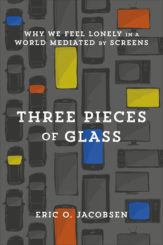
In the winter of my junior year of college, I traveled to Scotland to study at the University of Aberdeen. I arrived on campus just after the beginning of the new year. Growing up in Seattle, I thought I was impervious to winter gloom, but I was not prepared for this. The sun went down at three in the afternoon, and the old stone buildings made everything feel damp and chilly. The whole town had a lackluster feel, due in no small part to the economic slump of the North Sea oil industry.
I didn’t know anyone and felt very much alone. The food was unfamiliar, I had a hard time understanding the thick Scottish brogue, and the educational system was hard to navigate. My first Sunday there, I showed up to the beautiful old stone chapel on campus only to find its massive doors locked. The next week, I asked a theology professor about local churches, and he suggested a few.
The following Sunday, I walked in a misty rain through an industrial neighborhood to a church located in an ugly warehouse. The interior was unremarkable: a simple stage and rows of metal folding chairs on a concrete floor. After the welcome, the worship team led us in a praise chorus that I recognized immediately. Soon tears were streaming down my face. For the first time in weeks, I felt a powerful sense of belonging. After worship I stayed for fellowship and enjoyed getting to know some of the members of the church.
That experience of belonging was a turning point in that lonely season of my life. Belonging on Sunday permeated the rest of the week and helped me feel less lonely when I wandered the unfamiliar campus or spent an evening reading alone in my room. I traveled a lot on weekends, so I never got much involved in the life of that church, but I looked forward to returning there on weekends when I happened to be in town. Each time I felt a significant sense of belonging.
Belonging as Organized Complexity
During that season abroad, if someone had asked me how I was doing, I’d have said I was struggling with loneliness. My friends were back in school getting ready to begin a new term, and I was waking up each day in a single room thousands of miles away. This was before cell phones and Skype, so my primary form of communication with home was the aerogram letter. I longed for even an hour of face-to-face time with a friend.
This is a common way of understanding loneliness: as a lack of relational connection with another person. In chapter 9 I explore in detail why this approach is inadequate, but for now, I want to use this common pattern of thinking as a way of teasing out a more robust understanding of belonging. To do this, we need to draw a lesson from the field of urban planning.
Jane Jacobs’s seminal book The Death and Life of Great American Cities has a perceptive chapter titled “The Kind of Problem a City Is.” There she tries to account for why so many attempts at solving urban problems by so-called experts have failed. Jacobs contends that it has to do with a basic misunderstanding of what kind of problem a city presents. Jacobs describes three basic kinds of problems that call for different kinds of solutions.
Problems of simplicity look at two variables, and the solution involves adjusting one variable to positively influence another variable. City planners often treat parking as a problem of simplicity. We can estimate how many users a building will have and then require a certain number of parking spots to ensure that they will all have access to the building.
Problems of disorganized complexity involve too many variables to measure, so solutions are often based on statistics and complex modeling. Traffic engineers often deal with problems of complexity when recommending how many and what types of roads will be required in a particular area. Jacobs believes that dealing with the city as a problem of simplicity and as a problem of disorganized complexity both are too simplistic and fail to understand the internal logic of a city and neighborhood.
Jacobs advocates seeing the city as a problem of organized complexity. She sees the city as a kind of living organism that tends to function effectively even when we don’t understand how. Jacobs takes an inductive approach to dealing with cities and neighborhoods. She advocates paying attention to particulars and building general theories from there rather than beginning with general theories. Jacobs is aware of how one particular element in a city or neighborhood (like a park) exists as part of any number of complex systems that work together to shape the success or failure of the particular element.
I contend that belonging is a concept best studied as a case of organized complexity. It is tempting to deal with the crisis of belonging as a problem of simplicity: a loneliness problem whose proposed solutions tend to involve setting up friendships for people who lack them. Belonging can also be studied as a problem of disorganized complexity. We can look at the changing demographics of single-person households and try to account for them in terms of aging and mortality statistics. But belonging is much more nuanced and too complex to be fully comprehended using these kinds of methods. To understand the crisis of belonging and to work toward effective solutions, we first need to understand belonging as a complex but ultimately coherent phenomenon essential to human thriving.
Belonging is much more nuanced and complex…to understand the crisis of belonging and to work toward effective solutions, we first need to understand belonging as a complex but ultimately coherent phenomenon essential to human thriving.
Belonging as Relationship, Place, and Story
What does it mean to belong? While it seems like a straightforward concept, it can be tricky to pin down a precise definition. If we restrict ourselves to the variety of belonging we experience as humans, as opposed to, say, the way that my shirt belongs to me, it simplifies things.
Human belonging can include institutional, geographical, social, and/or cultural dimensions. We belong if we are on the official rolls of an organization. However, it is not unusual for a member of my church to report feeling they just don’t belong. The social dimension of belonging is often what people mean when they say they belong (or don’t belong). I feel I belong if I sense acceptance among a group of people. This can be formal, like belonging to a family, or informal and fluid, like belonging to a group of friends.
Belonging is often connected to geography. I have a sense of belonging if I have lived in a particular locale a long time, especially if I’m a third-generation resident. It’s possible to speed up the geographic sense of belonging by deliberately engaging with the natural and built environment of a place.
Last, there’s a cultural aspect to belonging. I feel like I belong if I don’t have to think too much before I speak or engage in an activity. Cultural belonging has to do with an internalization of the norms, patterns, and lexicon of a particular group or place.
The following is a working definition of “belonging” for the purposes of this book: “a sense of fitting in with a particular place, a particular group of people, and/or with the ethos or narrative of a place.” You belong when you don’t have to work too hard for a sense of acceptance.
Levels of Belonging
The belonging I felt in the social hall of the church in Scotland, I learned later, represented one of four experiential levels of belonging. The congregation knew that I was an American college student on a short-term stay in Scotland. I didn’t know any particular people in that church very well—where they lived, who they were related to, or what they did for a living. The powerful belonging I felt at that church was the kind of belonging appropriate to a church social hall.
Joseph Myers, in his book The Search to Belong, asserts that belonging is not a simple uni-dimensional concept. We do not simply belong or not belong to particular persons or groups. If we belong, we belong in different ways. Drawing on the insights of sociologist Edward T. Hall, Myers articulates four distinct levels within which we may or may not belong to persons or groups. These spaces not only provide the context for our belonging but also are governed by a set of rules and spatial relations that communicate and reinforce the kind of belonging that pertains in that setting. The four levels of belonging are intimate, personal, social, and public.
Intimate belonging is the kind of belonging we experience with our spouse or maybe a best friend. Myers describes this kind of belonging as “naked and unashamed.” We don’t keep any secrets from those with whom we experience intimate belonging. Personal belonging is the kind of belonging we experience with our families and close friends. We tend to know very well those with whom we experience personal belonging. We have mutually disclosed information that is personal and assumes a high level of trust.
Social belonging is the kind of belonging we experience with people whom we recognize but may not yet know very well. We experience social belonging at church coffee hour, the neighborhood dog park, or a PTA meeting. Social belonging is important but often overlooked. It is important for our identity formation. In settings geared for social belonging, we are often asked to explain who we are to another person, and it is often in formulating and articulating an answer to that question that we figure out who we are. Social belonging is also important to personal and intimate belonging. In settings for social belonging, we often self-select those with whom we want to experience personal or even intimate belonging.
Public belonging is the kind of belonging we experience with those whom we may not know personally but with whom we are connected through some external commonality. We experience public belonging as fans of the same sports team, as worshipers in the same sanctuary, or as denizens of the same town.
In considering these distinct levels of belonging, it’s important to avoid some common misunderstandings of how they work. First, we should understand that we all have a need to belong at all four levels. These levels of belonging are distinct but not sequential. We don’t move from public belonging to social belonging to personal belonging to intimate belonging. Rather, each of us needs to experience belonging at all four levels throughout our lives.
Furthermore, many of our relationships can exist at more than one level of belonging. More precisely, those with whom we experience one level of belonging should “scale up” to the larger realms of belonging. We experience intimate belonging with our spouse but also interact with our spouse at personal, social, and even public levels. It is important that we know how to navigate our spousal relations at all four of these levels if we want to have a healthy marriage.
With lots of programing targeted at marriages and small groups, the Christian community has focused perhaps too much attention on intimate and personal belonging… [and] has often neglected to recognize the importance of the civic level of belonging. In doing so, the Christian community has missed an opportunity to mitigate some critical aspects of loneliness within the congregation and the larger community.
With lots of programing targeted at marriages and small groups, the Christian community has focused perhaps too much attention on intimate and personal belonging. This is not a bad thing, since intimate and personal belonging are very important. However, at the same time, the Christian community has often neglected to recognize the importance of the civic level of belonging and in doing so has missed an opportunity to mitigate some critical aspects of loneliness within the congregation and the larger community.
 Eric O. Jacobsen (PhD, Fuller Theological Seminary) is senior pastor of First Presbyterian Church in Tacoma, Washington. He is the author of The Space Between: A Christian Engagement with the Built Environment, Sidewalks in the Kingdom: New Urbanism and the Christian Faith, and numerous articles exploring connections between the Christian community, the church, and traditional neighborhoods. He is also the coeditor of Traditions in Leadership and The Three Tasks of Leadership and cohost of the Embedded Church podcast. This excerpt is taken from Three Pieces of Glass by Eric Jacobsen, ©2020, and used by permission of Baker Publishing.
Eric O. Jacobsen (PhD, Fuller Theological Seminary) is senior pastor of First Presbyterian Church in Tacoma, Washington. He is the author of The Space Between: A Christian Engagement with the Built Environment, Sidewalks in the Kingdom: New Urbanism and the Christian Faith, and numerous articles exploring connections between the Christian community, the church, and traditional neighborhoods. He is also the coeditor of Traditions in Leadership and The Three Tasks of Leadership and cohost of the Embedded Church podcast. This excerpt is taken from Three Pieces of Glass by Eric Jacobsen, ©2020, and used by permission of Baker Publishing.


